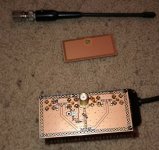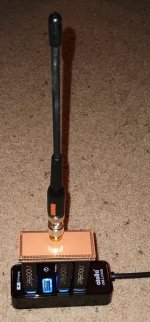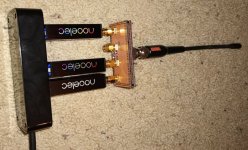Here's a 4-port active multicoupler that I put together.



The intended use case is to feed a bank of four RTL-SDR dongles plugged into a USB hub with a single antenna, but it can be used for other purposes as well. It can get power from one of the RTL-SDRs equipped with an internal bias tee or from external regulated 3 to 5 VDC. The SMA males connecting directly to the SDRs can easily be substituted with SMA females if cable connections are desired instead.
Design files and more details are here if anyone wants to make their own.
I just got the first prototype PCB assembled today and it seems to be performing about as expected, but I haven't taken any measurements with real test equipment yet.
Cost to build a single prototype was about $35 for parts, circuit boards, and shipping. I think I could get that down to $10 or $15 buying parts in larger quantities. If anyone is interested in participating in a bulk purchase, let me know what you'd be interested in:



The intended use case is to feed a bank of four RTL-SDR dongles plugged into a USB hub with a single antenna, but it can be used for other purposes as well. It can get power from one of the RTL-SDRs equipped with an internal bias tee or from external regulated 3 to 5 VDC. The SMA males connecting directly to the SDRs can easily be substituted with SMA females if cable connections are desired instead.
Design files and more details are here if anyone wants to make their own.
I just got the first prototype PCB assembled today and it seems to be performing about as expected, but I haven't taken any measurements with real test equipment yet.
Cost to build a single prototype was about $35 for parts, circuit boards, and shipping. I think I could get that down to $10 or $15 buying parts in larger quantities. If anyone is interested in participating in a bulk purchase, let me know what you'd be interested in:
- Fully assembled unit
- PCB only
- PCB and SMD + SMA connectors parts kit
- PCB and SMD only parts kit
- What gender SMA connector(s)

